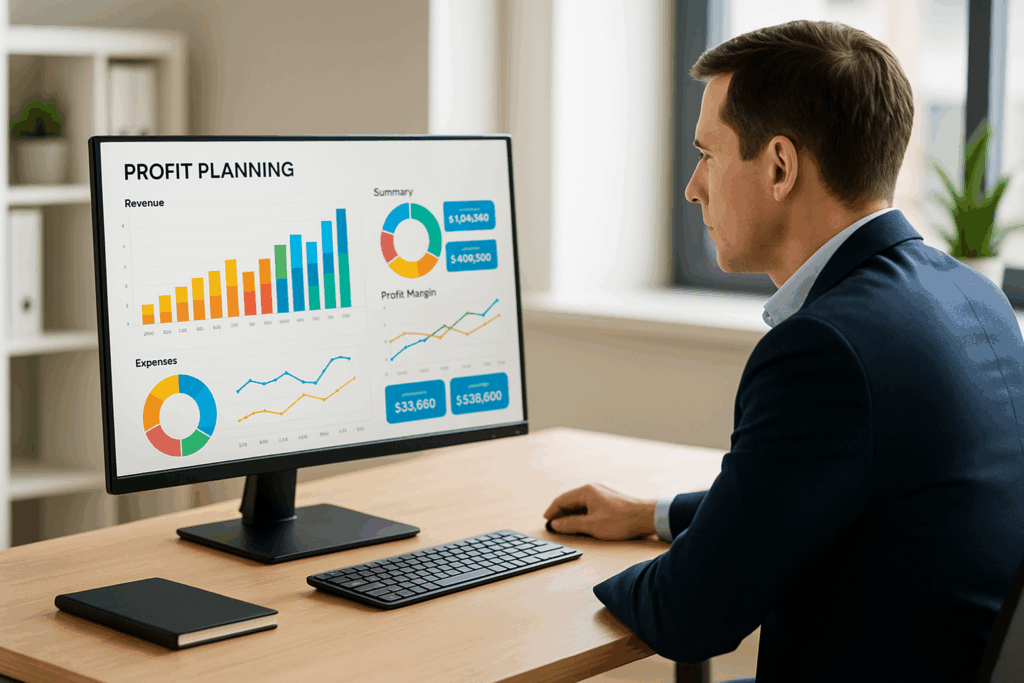Effective businesses don’t leave profitability to chance. They plan it. Mastering the profit planning essentials enables business owners to align resources, forecast future income, and make strategic decisions that drive sustainable financial growth.
This guide walks you through the foundational elements of profit planning—from setting measurable goals to optimizing cost structures—so you can build a more profitable and resilient business.
What Are Profit Planning Essentials?
Profit planning is the process of setting financial goals, forecasting income and expenses, and crafting a budget designed to ensure profitability. The essentials include:
- Analyzing past performance
- Projecting future revenue
- Managing fixed and variable costs
- Setting target profit margins
- Aligning financial goals with operational strategies
When executed consistently, profit planning transforms your financial vision into a structured, achievable reality.
🔍 Learn how our advisory services support profit-driven strategies
Why Profit Planning Is Crucial for Business Success
Ignoring financial planning leads to misaligned budgets, wasteful spending, and reactive decision-making. By contrast, a proactive approach:
- Helps predict cash flow needs
- Establishes clear profit benchmarks
- Identifies high-return investments
- Reduces surprises during tax season
- Informs better pricing and sales strategies
📘 Explore how we tailor profit planning by industry
Key Profit Planning Essentials to Implement Today
1. Set Clear and Measurable Financial Goals
Start with the end in mind. Your profit targets should be:
- Specific (e.g., $250K net profit in 12 months)
- Measurable (tied to real metrics like ROI or margin)
- Realistic (based on historical data and capacity)
- Time-bound (monthly, quarterly, annually)
Setting clear goals gives your team direction and accountability.
2. Conduct Break-Even Analysis
One of the core profit planning essentials is understanding when your business becomes profitable. This analysis involves:
- Identifying fixed and variable costs
- Calculating your break-even revenue
- Analyzing how pricing changes affect margins
It’s a simple but powerful tool for strategic pricing and budgeting.
3. Build a Profit-Focused Budget
Traditional budgets focus on spending limits. A profit-first budget flips the script by:
- Subtracting desired profit from projected revenue
- Allocating the remaining funds to essential operations
- Prioritizing ROI-driven expenses
This model ensures profit is planned—not what’s left over.
📊 Let us help you structure your financial roadmap
4. Monitor Profitability by Product, Service, or Department
Not all offerings are equally profitable. You should:
- Track gross margin per product/service
- Identify and eliminate low-performing revenue streams
- Invest more in high-margin segments
- Review profitability per client or account
These insights help optimize your business model over time.
5. Adjust Forecasts and Targets Regularly
Markets shift. Costs change. Profit planning is not static. Review your forecast monthly or quarterly to:
- Compare actuals vs. projections
- Identify financial bottlenecks
- Reallocate funds as needed
- Stay agile in competitive environments
📌 Book a review session to analyze and update your goals
6. Include Tax Planning in Your Profit Strategy
Many businesses overlook taxes when planning profits. You can increase net profitability by:
- Structuring income to reduce tax exposure
- Timing major expenses before year-end
- Leveraging credits and deductions
- Coordinating with your accountant or EA
Year-round planning beats last-minute scrambling every time.
🧩 Work with our team of tax and financial experts
Common Mistakes to Avoid in Profit Planning
Avoid these pitfalls to protect your profits:
- Setting unrealistic targets without data
- Failing to adjust when costs rise
- Ignoring operational inefficiencies
- Confusing revenue growth with profitability
- Not involving key stakeholders in financial planning
Planning profit requires intentionality, not assumptions.
Final Thoughts on Profit Planning Essentials
Understanding and applying the profit planning essentials empowers your business to grow with intention, clarity, and control. It’s not just about making money—it’s about making strategic financial choices that sustain and scale success.
🎯 Ready to start profit planning with purpose?
📲 Let our team help you set—and hit—your profit goals or connect on Facebook and Instagram for expert tips.
Frequently Asked Questions
1. What are the most important profit planning essentials?
They include setting measurable financial goals, budgeting for profit first, and reviewing financial data regularly.
2. How often should I review my profit plan?
At least quarterly, though monthly reviews are ideal for staying on track.
3. Can profit planning help with tax savings?
Yes. Coordinating tax strategy with financial goals improves net profits and reduces year-end surprises.
4. Is profit planning only for large businesses?
Not at all. Small businesses benefit immensely from structured profit strategies and proactive financial planning.
📈 Turn goals into growth with clear, actionable profit planning — Start your strategy today 💼
#ProfitPlanningEssentials




 por
por